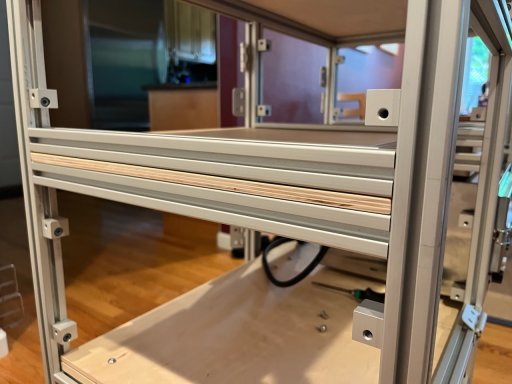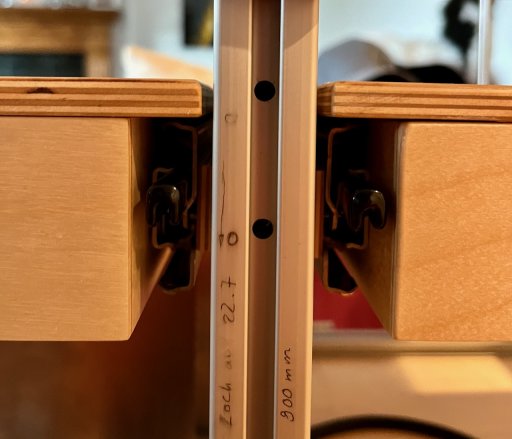
Creator III
- 6,480
- First Name
- Brandon
- Last Name
- Eberhardt
- Member #
-
20143
- Ham/GMRS Callsign
- KE0JBH
- Service Branch
- Air Force 02-18

Creator III
20143

Explorer I
23711
We considered this as well, but disliked the fact that most of these trailers are very wide. It might not be a problem, but we've been on many trails that were so tight, a seven feet wide trailer would be a challenge, especially when the travel goes beyond the realm of North America. Plus all the other challenges we had with trailers in general.We've opted to go the tear drop/square drop route ourselves.
It's been a revelation for us. One of the things my wife and I both hated was dealing with propane. We "travel". We like to see things. We like to take routes that aren't necessarily paved or in good conditions, but we aren't what you might see as the typical US West overlanders – going on very difficult trails, pushing their rigs to the limit, etc. All that means is that we aren't in this for camping and/or offroading lifestyle, we are in this to get around and see places.I would be curious to experiment with induction cooking in the future
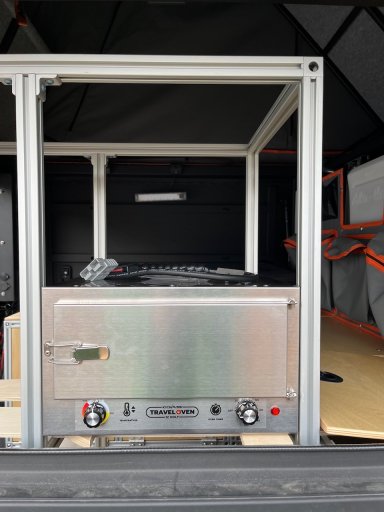

Explorer I
23711
A 7 foot wide trailer wouldn't fit where I wanna go most of the time either. That's why I'm building a 5 foot trailer.Yeah, the Patriot Camper is a brilliant setup if it fits your style of travel. We absolutely LOVED the space in the tent, the "change room" was awesome to have, and the quality of these things is just out of this world. My bet is, that if we had gone with the X1H or the X3, we would still be towing a trailer.
Our style of traveling is that we move pretty much every single day. We never go for a weekend of camping to one spot. Camping and all the gear and setup for it is a necessity we deal with to get away from people (therefore the Jeep, it gets easily just a little beyond where the Sprinter and Subaru crowds hang out) and to be independent – that's the reason for the cooking/sleeping/living setup.
We considered this as well, but disliked the fact that most of these trailers are very wide. It might not be a problem, but we've been on many trails that were so tight, a seven feet wide trailer would be a challenge, especially when the travel goes beyond the realm of North America. Plus all the other challenges we had with trailers in general.
It's been a revelation for us. One of the things my wife and I both hated was dealing with propane. We "travel". We like to see things. We like to take routes that aren't necessarily paved or in good conditions, but we aren't what you might see as the typical US West overlanders – going on very difficult trails, pushing their rigs to the limit, etc. All that means is that we aren't in this for camping and/or offroading lifestyle, we are in this to get around and see places.
Therefore, convenience is king.
Dealing with propane, while it might give that nice feeling of open flame cooking, is just a pain in the rear. As soon as you leave North America (which at some point we will), you deal with adapters, availability issues, regulations, etc. We also have a rig in Europe and believe it or not, every frigging country in Europe has different standards and regulations for attachments, fill stations, etc. It's completely bonkers. That's why so many people in Europe still use Butane or Iso-Butane/Propane mixes. The small canisters are generally available, but they are insanely wasteful and expensive. Plus, most of them don't work well in cold conditions, in high evelation, on odd weekdays, and generally have a temper I don't like to deal with. We have incredibly good experience with the MSR Windburner, but that's about it, and the only thing these stoves are good for is boiling water.
Cooking with induction is just plain incredible, once you have a setup together that works for you. Low temperature is very easy to regulate, it doesn't care about wind, it works in every temperature and every elevation, you can use it inside a camper without a second thought, and it also enables all the other goodness of electric cooking since you've already set up your electrical system to deal with the load. That includes air fryers, travel ovens, electric kettles, milk frothers if you're a coffee lover, even mixers or other things you may want to bring along a trip. And the best part is: you go to a hotel room once in a while to clean up, wash and dry clothers, have a long hot shower and real bed AND you can take that cooking equipment and are not relying on restaurants, takeouts, Starbucks, or whatever.
There is also no need to ever refill propane bottles. Cooking and heating the camper with propane would drive me nuts. It's okay for maybe a a few days or so or if you never have to use a heater, but as soon as it's cold, a heater is taking insane amounts of propane away from your cooking supply, depending on the setup, it might produce a lot of condensation, and so on. Yeah, we still have to install our diesel heater, but once that is done, the combination of electric cooking and diesel heating means we are relying on only one fuel to be replenished: diesel. The batteries are charged either via alternator while driving and the heater takes the same fuel as the truck.
A quick teaser of our plan regarding more electric cooking goodness:
View attachment 273629
Test fitting a 12V travel oven in our galley module (more to come on that later, we are still building it). We'll be using this to re-heat food and generally to have easy cooked meals ready when we arrive at camp – yes, this can be used while driving.
There are some other things we went a completely different route from the typical overlander, e.g. living space inside the tiny truck camper, a REAL composting toilet, no winch (this might actually change at some point), etc.
There is a whole bunch more information to come when I get the time to write it or when it's actually done ... ;-)
It really comes down what effort you want to deal with.I see your point about the propane being difficult once you leave the US. I don't share your hatret of propane (it's all I've ever used), but I completely understand your point of view. When taking a vehicle international, induction cooking would make sense.
It doesn't take much power (10A) and it doesn't get hot outside. But it takes forever to heat up. Plan for about 45 Minutes at least just to get to temp to get a slow cook started. If you can run it while driving it's better when you get higher voltage through the charging system. But with a modern car alternator even that isn't necesserily the case. We'll run it off LFP batteries, which seems to work okay in testing.Oh! A travel buddy!! I've wanted one for a long while. Maybe I find a way to put one in the trailer....

Explorer I
23711
I completely understand. The biggest benefit of building your own rig is that you get to build it to fit exactly what you need.It really comes down what effort you want to deal with.
We are doing some traveling in fall/winter conditions where we need a heater in the cabin, even just to protect the water and electrical systems. So it would run a lot. There is a Dickinson propane fireplace for the Canopy Camper, which would have to run about 10 to 14h per day at a low setting, using about 2lbs of propane per day. And I don't even know whether I could run it while driving – whether it's safe, which I assume it is.
Then add cooking, heating water for drinks and a shower from time to time. A propane bottle that is reasonable to carry with my rig (11lbs) would last maybe four to five days. That's too often for my taste.
If it's used just for cooking, it would last a few weeks, no problem, but then all the other problems I've experienced come into play. Wind sensitivity, low heat cooking issues (the Jetboil Gemini we have is a PoS, it's been broken most of the time we owned it), dealing with open flame, do I want to use an open flame inside the camper, and so on.
For us, it plain doesn't work. And we tried. It worked with the Patriot Camper, but again, that was a pain in the butt sometimes: three fuel types (gasoline for the car, diesel for the hot water system/heater, propane for cooking). I couldn't solve this issue fast enough even though I LOVED the Weber grill.
Most air fryers require around 1000w. We thought about doing that, but I'm trying to avoid putting in more than a 750w inverter.It doesn't take much power (10A) and it doesn't get hot outside. But it takes forever to heat up. Plan for about 45 Minutes at least just to get to temp to get a slow cook started. If you can run it while driving it's better when you get higher voltage through the charging system. But with a modern car alternator even that isn't necesserily the case. We'll run it off LFP batteries, which seems to work okay in testing.
If you are more into cooking when you arrive at camp, an air fryer might actually work much better, but needs much more power.

Advocate III
Curious to know your thoughts on that half-rack. This is the first one I've seen that's made to fit. I'm running an Ovrlnd Camper on my JT and it's a giant air dam. lolRoof Rack
We use Maxtrax recovery boards for their intended purpose, as well as leveling aids when the ground is uneven. I hate driving up on a rock or such and really prefer a more solid platform. The main issue for us has been where to store them during travel. On our previous trips we had them either just thrown in the rear where there was no furniture or under the storage platform where the rear seats used to be. That doesn't work long term for us since a) we now have furniture (more about that in a future post) and b) we need the space under the storage platform for other things.
On a different truck, we have them on a roof rack in front of the camper overhang and that has turned out okay. We wanted to do the same on the Jeep and, at the same time, also wanted a wind deflector that would direct air up and hopefully a bit better over the camper to improve fuel mileage on long trips.
The only rack I found that is made to fit the Gladator with the Canopy Camper is from Trailrax and we went with that – at some point, when we have more testing in, I'll write a review for it, but we only installed it today, so I can only give an installation overview.
The rack, assembled and just losely laying on the Jeep for a first impression:
View attachment 273599
We designed some brackets in a 2D drawing application, exported the file to SVG, and then had the brackets cut in stainless steel by an online service (OSH):
View attachment 273600
It fits great with the Maxtrax, is much lighter than the solution from Trailrax as well as less than half the price:
View attachment 273601
Front view, fully mounted:
View attachment 273602
We'll need another pair of boards, then I can check this off the to-do list.
Absolutely! And, while I have strong personal opinions about propane or other liquid fuel cooking options, if it works for you, that's all that counts! I just sometimes have stronger opinions than is good for myself ... ;-)I completely understand. The biggest benefit of building your own rig is that you get to build it to fit exactly what you need.
I can totally understand this point. This build has cost us A LOT. Especially time and nerves, but also in tools (we bought nearly all the tools needed to build this), learning curve (we had to learn a lot of new skills), and materials (we didn't want to use "cheap" stuff or cloned chinese copies of original designs, e.g. diesel heater). The build process we chose for the furniture also made it about 10x more expensive than it could have been. 80/20 extrusion is insanely expensive for something like this. If, at the start of the build, I had the woodworking knowledge and skills I have today, I would have built the whole furniture in baltic birch only. I would have been lighter, and probably about six to eight times cheaper. But, llive and learn.I'm struggling personally with the idea of having to carry multiple fuel types myself, but in the interest of build cost savings, it's really my only option.
Yes, that's a good start, but insufficient for induction cooking. We have probably the minimal setup necessary for that in terms of capacity. We chose Renogy batteries for their integrated BMS and self-heating option at a reasonable price, but went with Redarc for all the rest of the components. The whole system is:With my current setup, a 100Ah battery is more than sufficient, and can be charged with a 20A DC-DC charger, and augmented with a 200w solar panel.
Correct, that's the downside of them. We are already set up for high power consumption, so could have gone that route. The reason we didn't was that all the air fryers we found were either cheap stuff or too large. The cheap ones may or may not work properly, I have pretty bad experience and my motto has been "I'm not rich enough to buy cheap things". I've seen the "buy cheap, buy twice" too often.Most air fryers require around 1000w. We thought about doing that, but I'm trying to avoid putting in more than a 750w inverter.
Same! I've learned a lot from what people are doing. I like watching some of the Aussie Youtube channels, these guys are way ahead technologically compared to the typical American setup. Similar to the Europeans, but they do things slightly differently, mainly due to different typical weather conditions (more indoor living).I very much enjoy having conversations like this. Seeing how people think through the obstacles and issues that they have, and come to the conclusions they do helps the community as a whole.
I'd say in about two to three weeks we should have the galley module ready to show, then I'll do a complete walk-through for the furniture. Until then I'll probably describe some of the build process and ideas behind it.I can't wait to see more build progress from your setup!
Give me until Tuesday or Wednesday, we'll be on a 400 mile trip and should have some ideas on how it performs (without the Maxtrax this time, it's purely a roadtrip). So far, I'd say it should make things better, but they really couldn't be any worse than with a Gladiator and that bluntnosed camper on top.Curious to know your thoughts on that half-rack. This is the first one I've seen that's made to fit. I'm running an Ovrlnd Camper on my JT and it's a giant air dam. lol

Trail Blazer III
28559
I would highly recommend against the flexible panels, i had 9 of them on my setup and none of them lasted over 6 months, the majority got heat spots and about 50% reduction in output after about 3 months. Hard panels in my experience are going to be more efficient and hold up better. If you can fit them (imo) it would be the better choice.
- We don't have solar yet, but plan on adding a 150W CIGS flexible panel from Renogy since it's the only one that halfway satisfies my wishlist

Explorer I
23711
I'm so glad you spotted this thread. I was gonna throw out a mention so you could give your experience with the flexible panels.I would highly recommend against the flexible panels, i had 9 of them on my setup and none of them lasted over 6 months, the majority got heat spots and about 50% reduction in output after about 3 months. Hard panels in my experience are going to be more efficient and hold up better. If you can fit them (imo) it would be the better choice.
Was any of this experience with the newer CIGS panels? I’ve heard the same about the old flexible panels, but other than early model delamination issues from BougeRV I’ve heard only good things about the CIGS panels.I would highly recommend against the flexible panels, i had 9 of them on my setup and none of them lasted over 6 months, the majority got heat spots and about 50% reduction in output after about 3 months. Hard panels in my experience are going to be more efficient and hold up better. If you can fit them (imo) it would be the better choice.

Trail Blazer III
28559
They where not CIGS, from my experience I wouldn't risk it again. I definitely understand that weight is a prority.Was any of this experience with the newer CIGS panels? I’ve heard the same about the old flexible panels, but other than early model delamination issues from BougeRV I’ve heard only good things about the CIGS panels.
The reason I’m interested in the CIGS panels is weight. Using hard panels would mean a significant difference very high up in the rig.
I can wait a little bit on this and see whether reviews of these change my mind. We’ll see. I had originally planned on a hard panel, but including all the mounting hardware needed, I might end up nearly 20 lbs heavier up top and would prefer not to do this.They where not CIGS, from my experience I wouldn't risk it again. I definitely understand that weight is a prority.

Trail Blazer III
28559
That makes sense, having the solar is definitely a great thing to have, its "free" energy. The bougeRV 9BB/10BB panels are awesome, they dont weight too much and mounting materials are lightwight. I just got some Z-brackets and they are doing perfect. I've mounted a 400w panel and 10x100w panels with them, they have held up to wind/hail/snow/heat etc with no problems. But if there is a flexible option that works just as well its awesome, and weight saving is huge.I can wait a little bit on this and see whether reviews of these change my mind. We’ll see. I had originally planned on a hard panel, but including all the mounting hardware needed, I might end up nearly 20 lbs heavier up top and would prefer not to do this.
Definitely a big thank you for bringing this up. I may have talked myself into the CIGS panels from early good reviews. Will give it some time. We have enough DCDC charge power to just use that.
That means I probably need crossbars on top of the camper to mount the panel inbetween with the z-brackets. The loadbars are about 2.5kg per bar, so 5kg for the loadbars, about 12kg for a 200W panel (just looked up the Redarc, they are probably all similar), lets say another 500g for all the hardware – 17.5kg.I just got some Z-brackets and they are doing perfect.
We've been on a short road trip these last two days. About 300 miles actually, not the 400 planned, but long enough to get get some impressions:Curious to know your thoughts on that half-rack. This is the first one I've seen that's made to fit. I'm running an Ovrlnd Camper on my JT and it's a giant air dam. lol
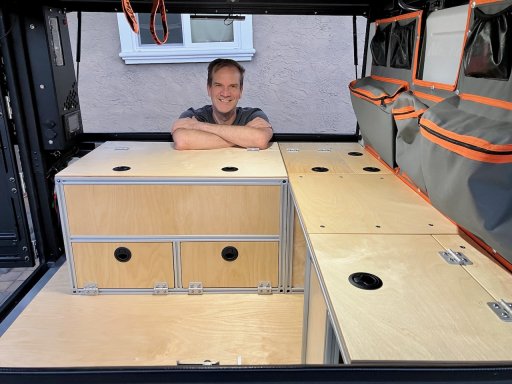
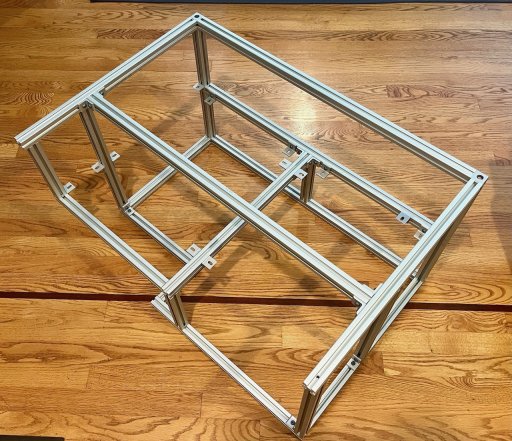
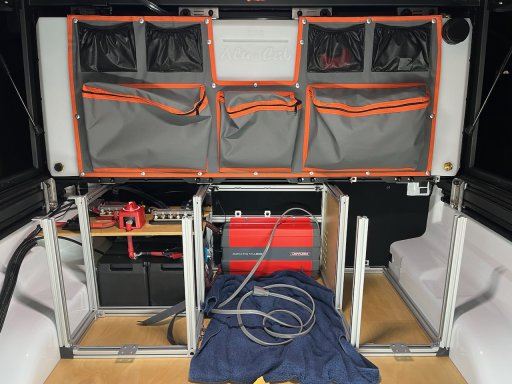
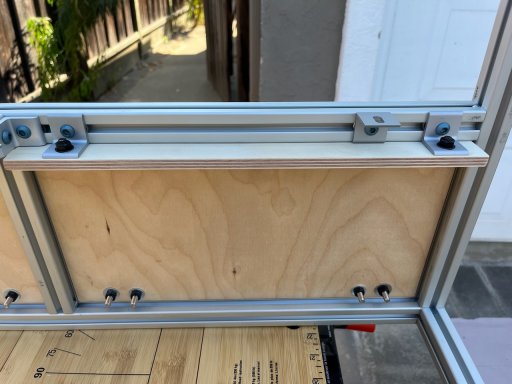
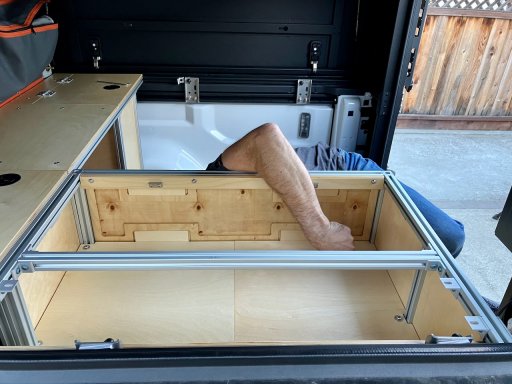
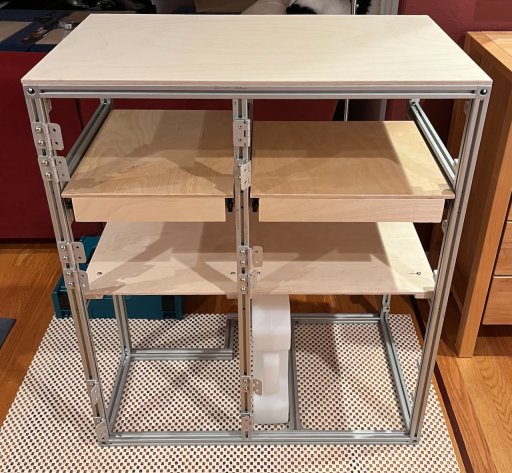
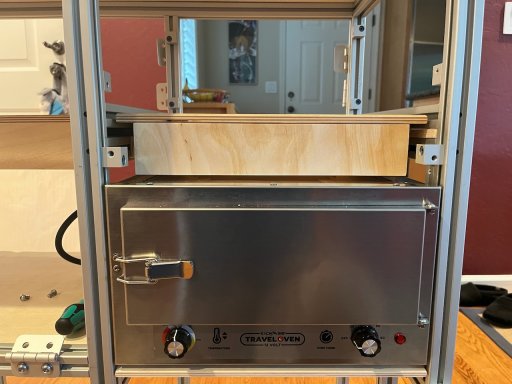

Explorer I
23711
80/20 is a wonderful material to build things out of for sure. The cost goes up exponentially when you start buying the connectors and all the other bits needed to put it together. I wanted to use it when I was building the drawers for my Xterra, but decided against it for the cost reason, ultimately.As I've mentioned before, we are building the interior of our Canopy Camper with 80/20. It's a great system that has all kinds of goodies and you can build amazing things with it. But, I want to put a damper on this.
There are some very nice upsides to using 80/20, like the flexibilty, stability, and – to a degree – ease of use. The issues start, when you really want to build furniture. It'll ALWAYS get more complicated than you thought in the beginning.
We aren't fully done yet with our interior build, so the following photos can be a teaser for a full walk through once the main parts of the furniture are all done.
When it's all done, it can look great – of course, depending on taste – and work really well:
View attachment 274113
The above is for all our clothing and personal stuff (straight on) and the "utility unit" (right side of the photo) which houses the batteries, inverter, some more electrical stuff, water pump, filter, toilet, etc.
When done it looks great, but it's a complicated beast underneath. The bench for our personal gear:
View attachment 274114
And the utility module:
View attachment 274115
There are tons of details that need to be sorted out that you wouldn't expect beforehand. Like, how do you install a latch keeper for the Southco latches:
View attachment 274116
The small piece of plywood across above the door holds the latch keeper and is used as a doorstop.
It can take a contortionist to get to some of the bolts/nuts/connections:
View attachment 274117
Of course, that's mainly because we designed our own furniture and probably made every mistake possible. But we learned a lot on the way.
Currently we are working on a galley module that will complete our furniture build, here's the current state:
View attachment 274118
This stuff gets complicated VERY fast – you start with something and then you go crazy. The above galley will have seven (7) doors, six on the front visible above, one more on the rear, which will also double as a table for outside, so we can utilize it when using our Travel Oven:
View attachment 274119
Now, all that being said, there are some difficulties in this.
The galley module has
All that resulted in
- Seven doors
- Two drawers
- The drawer double as small interior tables
- A sink
- A grey water tank
And an insane amount of time measuring, calculating, planning, re-thinking everything, re-working. Add some mistakes, some very colorful language, and a lot of frustration as well.
- 14 hinges,
- 36 panel mounts (yes, that's totally crazy, I agree),
- over 50 M6 taps,
- over 20 access holes drilled,
- over 45 individual wood pieces cut
I certainly hope it'll be worth it.
Give me a shout if you want to hear more about 80/20.
I've written a bunch of posts on another forum with thoughts, recommendations, tips&tricks and so on. It's not as easy as people make it out to be and there are tons of mistakes that could be avoided by knowing what you're getting into when using this system. I can summarize these here.
TLDR:
Use inside corner brackets and three-way corners during design/development of the furniture piece, replace with internal hardware for weight and cost savings. Re-use inside corner brackets to design/develop next piece.
